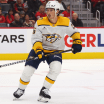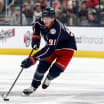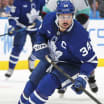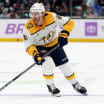NHL.com is providing in-depth analysis for each of its 30 teams throughout August. Today, the biggest reasons for optimism and the biggest questions facing the Columbus Blue Jackets:
After missing the Stanley Cup Playoffs last season, the Columbus Blue Jackets are banking on the core that led them to the postseason in 2013-14 doing so again.
That was with a different coach. John Tortorella took over for Todd Richards after an 0-7-0 start last season and spent much of his time eyeing the future.
Reasons for optimism, questions facing Blue Jackets
Young defense, goaltending will be key for Columbus

© Gregg Forwerck/Getty Images
By
Craig Merz
NHL.com Independent Correspondent
"It was a feeling-out process for him and the players as well," left wing Brandon Saad said. "Now we'll be more comfortable with knowing each other and the system. If you have that feeling, then you're confident that you have that trust to handle what comes your way."
The Blue Jackets made no major offseason moves and believe an infusion of talented young players who won an American Hockey League title with Lake Erie will make a difference. It's worked recently for the Tampa Bay Lightning, whose AHL affiliate, then the Norfolk Admirals, won the Calder Cup in 2012 with players including Tyler Johnson and Ondrej Palat.
Blue Jackets 30 in 30: Season outlook | Top prospects | Fantasy outlook
Here are four reasons for optimism entering this season:
1. John Tortorella's first training camp with Blue Jackets
When Tortorella missed a few days after fracturing his ribs following a fall on the ice during practice in January, he used his time to start planning camp.
He didn't give up on an already lost season but wanted to prepare for a grueling preseason that could help avoid the slow starts that plagued Columbus under Richards.
"If you look [Tortorella's] camps, it's the mental hurdle of how physically exhausted you are to get through it and say you've done it," captain Nick Foligno said. "After that, it's probably like you can do anything. That's huge for this group."
2. From underachievers to achievers
The burden of being the first Blue Jackets captain since Rick Nash in 2012 may have been too much for Foligno, especially after the bad start. Foligno went from being an all-star with 31 goals and 42 assists in 2014-15 to having 12 goals and 37 points last season.
"Any year not making the playoffs is a wasted year as far as I'm concerned," he said.
Expecting Foligno to score 30 goals every season might be too much, but 20 is within reach.
Goaltender Sergei Bobrovsky (15-19-1, 2.75 goals-against average, .908 save percentage) was another disappointment. The 2013 Vezina Trophy winner lost his confidence and winnable games early, and when he started playing well, persistent groin injuries returned. A healthy and dominating Bobrovsky can override many of the Blue Jackets' shortcomings.
3. The kids are coming
Several members of Lake Erie could play a pivotal role in avoiding a third straight April without the playoffs in Columbus.
Defenseman Zach Werenski and forwards Sonny Milano, Josh Anderson, Oliver Bjorkstrand, and Lukas Sedlak are on the cusp of becoming NHL players. So are goaltenders Anton Forsberg and Joonas Korpisalo.
"We're aiming at having players who are too good at the American league level," Columbus general manager Jarmo Kekalainen said. "It gives us flexibility at the NHL if we can't reach a contract that we feel makes sense for the organization long-term then we can fill that spot from our depth chart."
4. Three forwards each coming off career-best season
Given more ice time and responsibilities than Saad had with the Chicago Blackhawks, he scored an NHL career-high 31 goals.
Forward Cam Atkinson improves each season. He's gone from 21 goals to 22 to 27 in the past three seasons.
Forward Boone Jenner showed his versatility by moving to center and scored 30 goals, 14 more than his previous best as a rookie in 2013-14.
Here are three key questions facing the Blue Jackets:
1. Can a young defense be successful?
The opening night roster on Oct. 13 could have the top three defensemen age 23 or younger: Ryan Murray (23), Seth Jones (22) and Werenski (19).
Although all but Werenski have at least three seasons of NHL experience, the pressure is on to improve one of the NHL's worst defenses. Columbus allowed 3.02 goals per game, which ranked 29th in the League.
It's not all on them, and Tortorella will emphasize the need for the forwards to not put the defense in vulnerable positions.
2. Will Sergei Bobrovsky be the No. 1 goalie?
A best-case scenario is the oft-injured Bobrovsky plays more than the 37 games he played last season, which dropped his three-year average to 48.7 games. An optimistic outlook would be 55-60 games. The worst-case scenario is Bobrovsky is injured or subpar again and the backups struggle.
Veteran Curtis McElhinney, who is in the final year of his contract, could be the odd man out with Korpisalo and Forsberg emerging.
Forsberg was outstanding in the AHL playoffs with a 1.34 GAA. Korpisalo impressed enough in 31 NHL games (16-11-4, 2.60 GAA, .920 save percentage) that he could push Bobrovsky for the No. 1 spot.
"I come in every season with the mindset to prove something, to be better," Bobrovsky said. "Next season will be no different. I can't control how other guys play. More important is to focus on myself and my systems, and keep myself healthy and help my teammates."
3. Will Columbus improve under John Tortorella?
Given Tortorella's track record of improvement -- he won the 2004 Stanley Cup in his third full season with the Lightning -- it is reasonable to expect the Blue Jackets to make major strides this season.
But a 17-point bump to the 93 points the Detroit Red Wings needed to qualify as the second wild card into the playoffs from the Eastern Conference last season might prove difficult, especially in a Metropolitan Division with the Stanley Cup champion Pittsburgh Penguins and defending Presidents' Trophy-winning Washington Capitals.

















